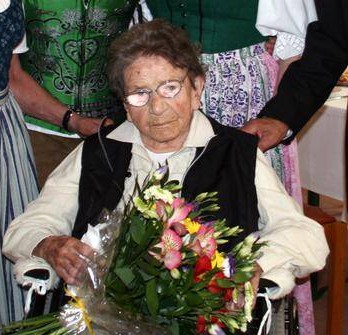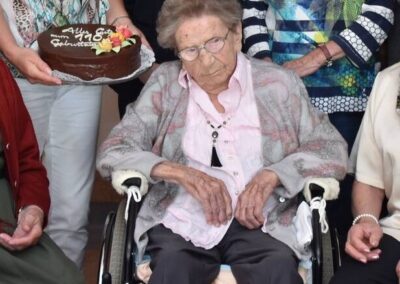Aloisia Karlhuber (née Scheuchenstuhl) was an Austrian supercentenarian. Her age has been validated by the European Supercentenarian Organisation (ESO).
BIOGRAPHY
Aloisia Karlhuber was born in Haidershofen, Lower Austria, Austria, on 19 May 1907. In 1913, Aloisia’s family moved to Krühub, a district of Kremsmünster, after her father was transferred to a railway job. She attended the Bürgerschule (community school) in Krühub, which later became an elementary school. At that time, she had to travel all the way to Linz to take her exams.
After the First World War, her father faced a difficult choice: either sell the large property in Kremsmünster, which provided a modest livelihood, or give up his railway job to someone in greater need. In the end, the family returned to Haidershofen. Unfortunately, the proceeds from selling their once-stately property were lost to the hyperinflation of the interwar period.
After finishing school, Aloisia began an apprenticeship as a tailor in Steyr, eventually earning her master craftsman’s certificate. She was in a relationship with train driver Karl Karlhuber from Ernsthofen for seven years before she had saved enough money for a dowry to marry. During that time, she worked as a journeyman in Weyer and Ternberg. The couple married in 1934, but it was not until four years later that they started a family. Their first child, Gertrude, was born in 1938, followed by Herta in 1940. Tragically, their son Max, born in 1942, died of measles and pneumonia before his first birthday. Their youngest child, Karl, was born in 1944.
The family was fortunate during World War II: Karl was not drafted into the German Wehrmacht. Instead, he continued working as a train driver, and his train was only bombed once. In 1945, when two escaped concentration camp prisoners swam across the Enns River seeking refuge, Aloisia courageously used a razor blade to remove their tattooed prisoner numbers and disguised them as farm workers.
After the war, Aloisia trained numerous seamstress apprentices. Since Haidershofen was in the Soviet occupation zone, her husband placed a post against the front door to protect his wife and three children from invading Russian soldiers.
She was widowed in 1961. Her youngest son Karl died in 2015, at the age of 71.
By the time she was 108, her family had grown to include six grandchildren, 12 great-grandchildren, and eight great-great-grandchildren.
In August 2007, she moved into the St. Peter State Nursing Home. Until the age of 100, she had been cared for at home by her daughter, Herta Winkler. At 107, she no longer actively participated in the home’s activities but still enjoyed joint celebrations with kindergarten and school children. Although she was wheelchair-bound, she remained in good health, despite having lived with only one kidney since 1947.
Aloisia Karlhuber passed away in Haidershofen, Lower Austria, on 21 July 2017, at the age of 110 years, 63 days.
RECOGNITION
Karlhuber’s age was verified by Dr. Andrew Holmes and Stefan Maglov, and was validated by the ESO on 10 May 2021.
ATTRIBUTION
* “Im Kaiserreich geboren” – Nön, 2 June 2014
* “109. Geburtstag gefeiert” – Nön, 24 May 2016
* “Älteste Frau im Bezirk Amstetten ist 110 Jahre” – Nön, 23 May 2017
* “Aloisia Karlhuber: 110 Jahre mit starkem Willen” – Wirtrauern
[crp limit=’4′ ]


